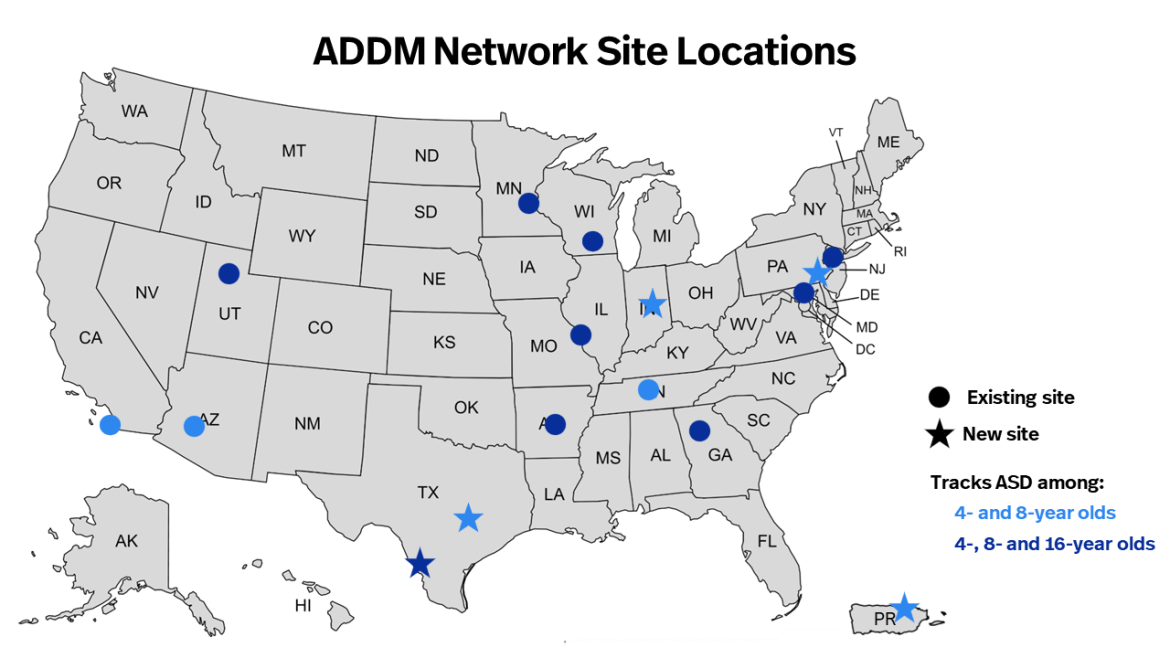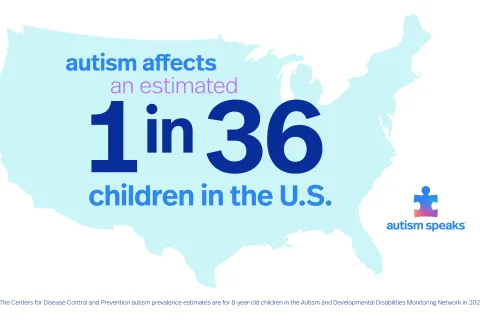ADDM Network adds new sites, offering opportunities for new insights on autism
Growth in network results from efforts by Autism Speaks, colleague organizations and grassroots advocates
April 25, 2023This week, we proudly celebrate a historic expansion of the Autism and Developmental Disabilities Monitoring (ADDM) Network, from 11 to 16 sites across the country. The ADDM Network is the only collaborative network to track the number and characteristics of children with autism spectrum disorder (ASD) and other developmental disabilities in multiple communities throughout the United States. This is the first time since 2010 that the ADDM Network has added sites to its prevalence and surveillance work. The data and knowledge provided by the ADDM Network continues to inform and drive us forward in identifying gaps in diagnosis, improving screening tools and developing programs to reach underserved communities.
Autism Speaks has advocated in support of the CDC's autism activities for decades, through our advocacy for the Autism CARES Act, as well as supporting annual appropriations requests that have sustained and grown the level of funding for federal autism programs. It is thanks to our champions in Congress, the advocacy of Autism Speaks, partner organizations and countless advocates that spent years fighting for additional funding and successfully saw that the Consolidated Appropriations Act of 2023, enacted earlier this year, provided the Centers for Disease Control and Prevention (CDC) with support for the expansion of their work. As a result, the ADDM Network is now in its sixth phase of funding and includes fifteen funded sites and one CDC-managed site in Georgia (MADDSP).
The newly awarded sites include locations in Indiana, Pennsylvania, Texas (Austin) and Texas (Laredo) as well as Puerto Rico, marking the first time a US territory will be included in this research. Each ADDM site’s surveillance activities are different so that they collectively contribute to a fuller picture of what we know about autism. While every ADDM Network location will track ASD among 4- and 8-year-old children, nine sites will now also track transition planning and co-occurring conditions among 16-year-old children with ASD. This is almost a two-fold increase from five sites in previous years.
Understanding the number of people affected by autism, their characteristics and ability to access information and care is a fundamental tool that empowers researchers, clinicians, policymakers, families and those on the autism spectrum. Just last month, new autism prevalence data from the CDC was published, identifying an increase in prevalence with 1 in 36 children diagnosed with autism spectrum disorder in the United States. It also revealed prevalence differences among genders, those with intellectual disabilities, and most notably, minority communities where for the first time higher prevalence rates among Black non-Hispanic, Hispanic and Asian/Pacific Islander children were reported compared to White non-Hispanic children.
Already, the CDC has used its recent data collection on adolescents to publish findings on the healthcare needs and transition planning of youth with autism. The more we understand about the autism population, the better we can develop innovative tools and lifespan services that are accessible to and meet the needs of all autistic individuals across the spectrum and throughout their lives. The addition of more ADDM sites will only expand our understanding of autism prevalence and ability to better ascertain the future of autism research and services.
|
City |
State / Territory |
Funded Site |
Ages Tracked |
|
Arizona |
Arizona Board of Regents, University of Arizona |
4 and 8 |
|
|
Arkansas |
University of Arkansas for Medical Sciences |
4, 8, and 16 |
|
|
California |
University of California, San Diego |
4 and 8 |
|
|
Georgia |
Intramural Site | Metropolitan Atlanta Developmental Disabilities Surveillance Program (MADDSP) |
4, 8, and 16 |
|
|
Indianapolis |
Indiana |
Indiana State Department of Health |
4 and 8 |
|
Maryland |
Johns Hopkins University |
4, 8, and 16 |
|
|
Minnesota |
Regents of the University of Minnesota |
4, 8, and 16 |
|
|
Missouri |
Washington University in St. Louis |
4, 8, and 16 |
|
|
New Jersey |
Rutgers Biomedical and Health Sciences |
4, 8, and 16 |
|
|
Philadelphia |
Pennsylvania |
Department of Human Services - Pennsylvania |
4 and 8 |
|
Puerto Rico |
Puerto Rico |
San Juan, Puerto Rico Department of Health |
4 and 8 |
|
Tennessee |
Vanderbilt University Medical Center |
4 and 8 |
|
|
Austin |
Texas |
The University of Texas at Austin |
4 and 8 |
|
Laredo |
Texas |
City of Laredo |
4, 8, and 16 |
|
Utah |
University of Utah |
4, 8, and 16 |
|
|
Wisconsin |
Board of Regents of the University of Wisconsin System |
4, 8, and 16 |









